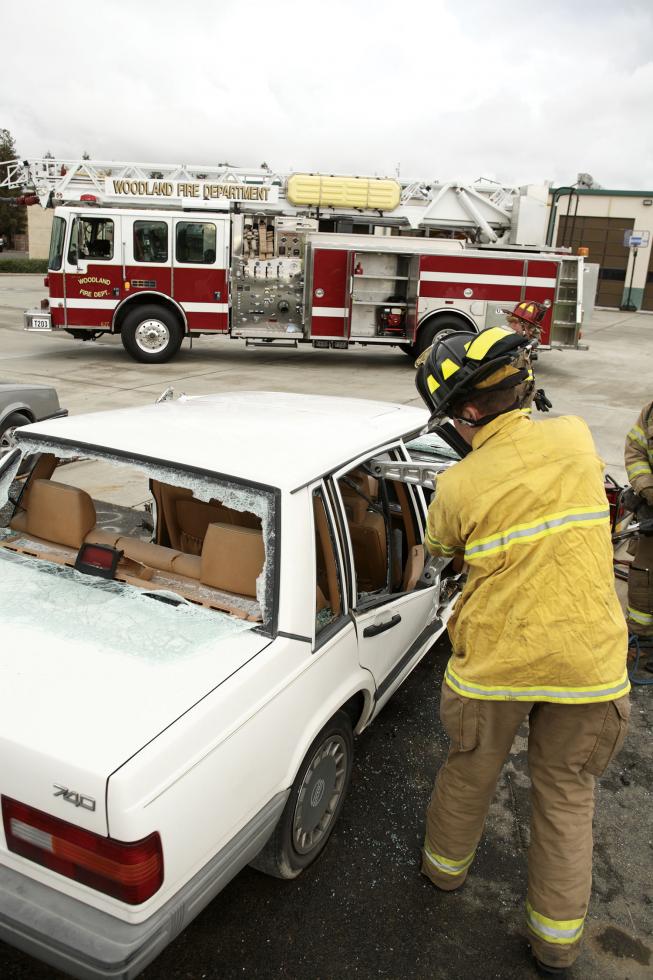Cities nationwide have welcomed hoards of elected officials who will have little time to celebrate their appointments before confronting daunting financial challenges. Among Capital Region cities, public safety budgets and all they encompass — cuts, swollen pensions, potential new fees, layoffs and department closures — have become the most contentious load to bear.
Since 2008, dozens of cities have shed hundreds of police officers and firefighters, shuttered firehouses and deferred pay raises and vacation time for first responders.
Cities such as Ione have put off replacing old police vehicles. In Sacramento, abandoned vehicles remain on city roads for up to 17 days, instead of being towed after a maximum of seven days. In multiple cities fire stations are on a rotating “brownout” or one-day closure schedule. In Lincoln, just two fire engines are operating where there would typically be four to serve a city of roughly 42,000 residents. That city has also suspended all gang intervention programs.
Local unions have agreed to contract concessions in an effort to assist city leaders in balancing budgets. In some cities the give and take has been amicable and effective, but in others, cuts have caused a deep rift between labor and government.
Stockton is a city dealing with frayed relations. In June city leaders voted to impose deep cuts to police and fire operations, including 26 additional officer layoffs (that makes 99 since 2008) and the temporary closure of one firetruck company, in an effort to close a $23 million deficit in the city’s $166 million general fund budget.
“All the cities are facing revenue shortfalls, and public safety is taking hits just like any other department. We’re down 46 firefighter positions since 2008,” says Dave Macedo, president of Stockton Professional Firefighters Local 456.
To help the city meet its budget, Local 456 agreed to about $13 million in concessions, including deferral of pay raises and vacations. Still, city officials needed the union to muster up another $5.7 million in cuts. The reaction from the union was visceral. Local 456 would pay more into health care and pension funds, but not without an expensive contract renewal. The city, meanwhile, had its sights set on eliminating the union’s option for binding arbitration with a third-party negotiator and regaining control over staffing.
So the city put Measure H on the ballot in November, which would repeal the union’s right to binding arbitration, make the fire chiefs at-will employees and allow the city to hire a fire chief from outside local ranks. Stockton firefighters opposed the measure, but it passed, and beginning Jan. 1 the city regained control of staffing decisions. One projection from the International City/County Management Association estimates Stockton could save $10 million by rearranging fire and police staff.
“On the fire side, the vast majority of calls are not fire related. They’re related to medical issues,” says City Manager Bob Deis. “So the risk to the average citizen is not the risk of being a victim of a fire; it’s the risk of being the victim of a crime, but the council didn’t have authority to adjust staffing. [The passage of Measure H] is going to reduce the chances of additional cuts, it’s going to help us balance our budget and it’s going to help reduce the likelihood of police reductions, which is where we really need the resources. With any luck, we might be able to add resources.”
The average total compensation for a firefighter in Stockton is $188,000 a year, though the city is trying to fend off an arbitration that could increase that amount to $203,000.
“If we lose at arbitration, it will cost us $5.5 million that we don’t have,” Deis says.
Now, many cities are looking for new ways to generate revenue for public safety budgets.
The city of Sacramento, for example, is seeking cost-recovery opportunities, including requiring at-fault drivers in traffic accidents necessitating fire response to pay a fee for service, regardless of residency. City managers in Sacramento have proposed fees ranging from $432 to $2,200. City Council will vote on the fee adoption this month.
Mayor Kevin Johnson says he opposes the so-called “crash-tax” (It’s technically a fee.), though he told local news outlets he thought the plan “made good business sense” when the issue was broached in February 2010.
Such fees are often covered by auto insurance policies and are used by more than 60 other cities in the state, including San Francisco, Roseville and Woodland. The average response cost in Woodland, for example, is about $260 an hour and increases depending on the fire personnel required for the response and any operation of special equipment.
Implementing such a fee in the capital city “could keep our fire department service up, and we estimate it could bring us a little over $1 million a year,” says Patti Bisharat, interim assistant city manager.
Woodland implemented its at-fault accident fee in 2009 as a way to help fill a nearly $5 million budget deficit, says Kim McKinney, the city’s finance officer. So far, the plan hasn’t lived up to the city’s projections.
“It was a touchy subject because it’s not a politically popular thing to do,” McKinney says. “It’s not bringing in as much revenue as we thought it would. Last year we budgeted for about $175,000, and we actually only brought in about $40,000.”
And new funding sources can only do so much if cities can’t stop the financial bloodletting. Many would argue the first gash to mend is ballooning pension costs. In cities like Vallejo, Stockton and Sacramento, some say pensions have cut into funding needed for other services.
“Our current pension program is unsustainable, and we have a fairly modest program compared to many cities.”
Bob Deis, city manager, Stockton
“The pension issue is killing us financially,” Deis of Stockton says. “Our current pension program is unsustainable, and we have a fairly modest program compared to many cities. For public nonsafety workers it’s 2 percent at age 55, and for public safety its 3 percent at 50. Every year for the next three years our pension costs are going to go up by an estimated $3.5 million per year.”
Pension problems are the result of two factors: rising costs as a result of contractual payout increases combined with significant losses in pension fund investments — investments that used to produce returns to fund cities’ pension budgets.
“The council is committed to trying to live within their means, and the question is whether the employees are willing to sit down and discuss cuts in compensation over the next few years,” Deis says. “Because it’s either concessions or cuts.”
In Vallejo, public safety workers receive a retirement payout of 90 percent of their former salaries — for life. That provision was adopted in Vallejo in 2002 as a way to attract new recruits.
Now, the bankrupt city is facing a crippling unfunded pension liability of close to $200 million. In early December, the City Council adopted a budget plan that would hopefully pull it out of bankruptcy within five years. The city, which axed 40 percent of its police and fire budget after running out of money, plans to trim benefits and health care premiums, among other efforts. The budget blueprint will be presented to a federal bankruptcy judge later this month.
The Vallejo’s finance director didn’t return calls and emails seeking comment.
In Stockton, Deis says medical insurance for retirees is another source of bleeding funds. “The benefit that has been promised in Stockton is extremely high and extremely expensive,” Deis says. “It’s costing us about $14 million per year, and it’s expected to rise a couple million dollars every year.”
Woodland is in the same predicament. Every city employee — not just public safety workers — hired prior to July 2006 receives lifetime medical benefits. The city has implemented a more affordable cafeteria plan since then, but the unfunded liabilities remain at about $56 million amortized over 30 years, according to McKinney.
There aren’t a ton of solutions on the table to fix the problem going forward. McKinney says, “There is so much talk about socialized health care options, and if that becomes a reality it will substantially decrease [the city’s] liability.”
Meanwhile, Stockton is conducting legal reviews on its options, Deis says. “What is clear is that retirees have special status, and their defined benefit program is essentially untouchable. So there are big restrictions there. In regard to current employees, it’s not like we’re going to just lay down the law. We have to start a conversation about options. At the end of the day, the budget has to be balanced. We can’t play games like the state government and the federal government. The only other option is cutting more staff.”
Still, other cities like Rancho Cordova and Citrus Heights have been able to avoid the pension and insurance fray altogether by outsourcing services. Rancho Cordova, for example, contracts with the Sacramento County Sheriff’s Department, which provides vehicles and officers for the city.
“As a contract city you don’t have to deal with a lot of the union issues: You don’t have to lay people off, you contract for the work that you need when you need it and when you don’t need it you reduce the scope of your contract,” says Rancho Cordova’s Finance Director Donna Silva. “It allows us to react quickly. We decide on staffing levels and a price annually. In our most recent contract, if [the sheriff’s department is] to lay off their people, they cannot pull from our forces.”
The contract model is common practice in many southern California cities, particularly in Los Angeles County. Silva says it has been working well for Rancho Cordova, which hasn’t had to make drastic cuts to public safety services.
“Where we save is not in direct dollars but in efficiency because we are not spending our time at the bargaining table negotiating contracts,” she says. “It frees us up to focus on other areas.”
Recommended For You

Commanding Presence
Business, safety and the future of the Sac PD
Sacramento Police Chief Sam Somers Jr. is still fairly new to his position, but he is hardly fresh to Sacramento or law enforcement.

All Eyes on Kay
Beefed-up security steadies K Street
Sac Town revelers along K Street seem oblivious to new coordinated efforts by the Sacramento police, city officials, pubs, clubs and bars to deploy new layers of security and preparedness which, well, probably account for the harmony on this Friday evening in March.



